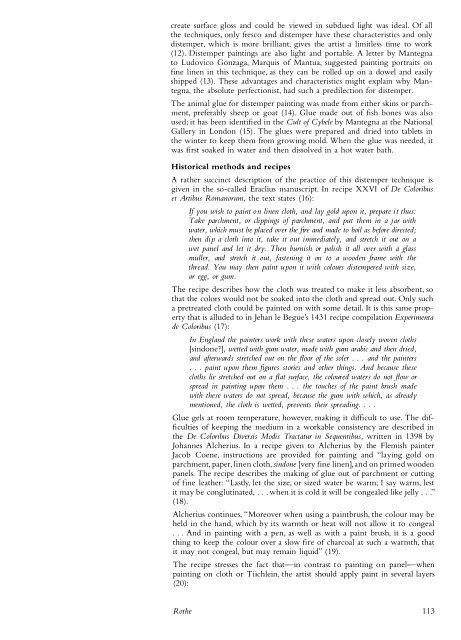Historical Painting Techniques, Materials, and Studio Practice
Create successful ePaper yourself
Turn your PDF publications into a flip-book with our unique Google optimized e-Paper software.
create surface gloss <strong>and</strong> could be viewed in subdued light was ideal. Of all<br />
the techniques, only fresco <strong>and</strong> distemper have these characteristics <strong>and</strong> only<br />
distemper, which is more brilliant, gives the artist a limitless time to work<br />
(12). Distemper paintings are also light <strong>and</strong> portable. A letter by Mantegna<br />
to Ludovico Gonzaga, Marquis of Mantua, suggested painting portraits on<br />
fme linen in this technique, as they can be rolled up on a dowel <strong>and</strong> easily<br />
shipped (13). These advantages <strong>and</strong> characteristics might explain why Mantegna,<br />
the absolute perfectionist, had such a predilection for distemper.<br />
The animal glue for distemper painting was made from either skins or parchment,<br />
preferably sheep or goat (14). Glue made out of fish bones was also<br />
used; it has been identified in the Cult of Cybele by Mantegna at the National<br />
Gallery in London (15). The glues were prepared <strong>and</strong> dried into tablets in<br />
the winter to keep them from growing mold. When the glue was needed, it<br />
was first soaked in water <strong>and</strong> then dissolved in a hot water bath.<br />
<strong>Historical</strong> methods <strong>and</strong> recipes<br />
A rather succinct description of the practice of this distemper technique is<br />
given in the so-called Eraclius manuscript. In recipe XXVI of De Coloribus<br />
et Artibus Romanorum, the text states (16):<br />
If you wish to paint on linen cloth, <strong>and</strong> lay gold upon it, prepare it thus:<br />
Take parchment, or clippings if parchment, <strong>and</strong> put them in a jar with<br />
water, which must be placed over the f ire <strong>and</strong> made to boil as before directed;<br />
then dip a cloth into it, take it out immediately, <strong>and</strong> stretch it out on a<br />
wet panel <strong>and</strong> let it dry. Then burnish or polish it all over with a glass<br />
muller, <strong>and</strong> stretch it out, fastening it on to a wooden frame with the<br />
thread. You may then paint upon it with colours distempered with size,<br />
or egg, or gum.<br />
The recipe describes how the cloth was treated to make it less absorbent, so<br />
that the colors would not be soaked into the cloth <strong>and</strong> spread out. Only such<br />
a pretreated cloth could be painted on with some detail. It is this same property<br />
that is alluded to in Jehan Ie Begue's 1431 recipe compilation Experimenta<br />
de Coloribus (17):<br />
In Engl<strong>and</strong> the painters work with these waters upon closely woven cloths<br />
[sindone?], wetted with gum water, made with gum arabic <strong>and</strong> then dried,<br />
<strong>and</strong> afterwards stretched out on the floor if the soler ... <strong>and</strong> the painters<br />
... paint upon them figures stories <strong>and</strong> other things. And because these<br />
cloths lie stretched out on a flat suiface, the coloured waters do not flow or<br />
spread in painting upon them . . . the touches of the paint brush made<br />
with these waters do not spread, because the gum with which, as already<br />
mentioned, the cloth is wetted, prevents their spreading . ...<br />
Glue gels at room temperature, however, making it difficult to use. The difficulties<br />
of keeping the medium in a workable consistency are described in<br />
the De Coloribus Diversis Modis Tractatur in Sequentibus, written in 1398 by<br />
Johannes Alcherius. In a recipe given to Alcherius by the Flemish painter<br />
Jacob Coene, instructions are provided for painting <strong>and</strong> "laying gold on<br />
parchment, paper, linen cloth, sindone [very fme linen], <strong>and</strong> on primed wooden<br />
panels. The recipe describes the making of glue out of parchment or cutting<br />
of fine leather: "Lastly, let the size, or sized water be warm; I say warm, lest<br />
it may be conglutinated, ... when it is cold it will be congealed like jelly ..."<br />
(18).<br />
Alcherius continues, "Moreover when using a paintbrush, the colour may be<br />
held in the h<strong>and</strong>, which by its warmth or heat will not allow it to congeal<br />
... And in painting with a pen, as well as with a paint brush, it is a good<br />
thing to keep the colour over a slow fire of charcoal at such a warmth, that<br />
it may not congeal, but may remain liquid" (19).<br />
The recipe stresses the fact that-in contrast to painting on panel-when<br />
painting on cloth or Tiichlein, the artist should apply paint in several layers<br />
(20):<br />
Rothe 113


